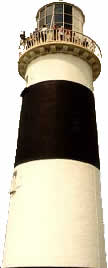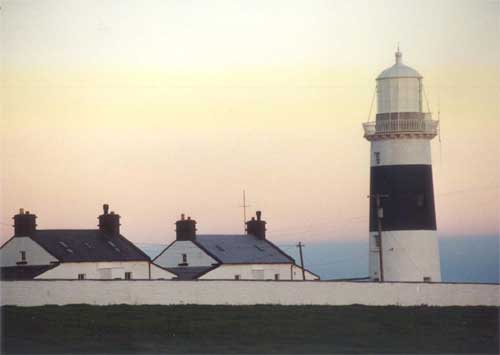Old
Parish - An Sean Phobal
An
Sean Phobal - The Oldest Parish in Ireland
Before the famine in the mid-19th century, An
Sean Phobal (Old Parish) contained a much larger
population than it does today. An Sean Phobal,
together with An Rinn (Ring) forms the Waterford
Gaeltacht. About 13 km (8 mls) from Dungarvan,
An Sean Phobal is a large parish covering about
35 square kilometres (14 sq.mls) with
approximately 8 km (5 mls) of coastline. This
coastline consists of a dramatic seascape
comprising of cliffs (approximately 70 m, 230
ft., high) together with a number of deeply
incised stream gullies and small bays. The
unimproved grassland along the cliffs attracts a
wide variety of seabirds. An Sean Phobal is a
paradise for bird-watchers and people interested
in nature.
The most prominent man-made feature is the Mine
Head Lighthouse. The seas along this stretch of
coast are notoriously rough and numerous wrecks
are known to lie offshore.
Built some 4,000 years before the lighthouse is
another man-made structure - a pre-celtic
Megalithic Tomb, the only example of its kind in
County Waterford. The spectacular cliff-top
location, with stunning views across to the East
Waterford and Wexford coastline to the
Hook Head Lighthouse and beyond leave
no visitor in any doubt as to why this tomb was
built in exactly this location with an all
overlooking view.
Mine
Head Lighthouse
George Halpin Senior designed the major light of
Mine Head (navigational location 51° 59.6' N 7°
35.2' W). The red sandstone structure sitting on
top of the steep cliffs of Old Parish is higher
above sea-level (88 m, 290 ft.) than any other
Irish lighthouse. The red sandstone structure sitting on
top of the steep cliffs of Old Parish is higher
above sea-level (88 m, 290 ft.) than any other
Irish lighthouse.
Local merchants and mariners from Youghal and
Cork pressured the Ballast Board to begin a
lighthouse tower on Capel Island off Youghal.
This building was begun even though George
Halpin felt the best place for a light was on
Mine Head. The work was well under way when the
local people changed their mind and decided that
the light should be at Mine Head after all.
After much debate, including input from Trinity
House and the Admiralty, it was decided to
abandon the site on Capel Island and build on
Mine Head.
The light was established on 1 June 1851, the
same day as Ballycotton lighthouse.
Mine Head has a 22 m (72 ft.) white tower with a
black band. It was coverted to electricity in
Sept. 1964. The beacon flashes white and red
every 2.5 sec. and has a nominal range of 52 km
(28 nautical miles) since it sits so high above
sea-level. Today the
Commissioner of Irish Lights operates
the lighthouse, which is not open to the public
and is not accessible.

Mine Head Lighthouse
Megalithic Tomb - Carn Chúirte Bhaile Na Moná
- Ballynamona Court Cairn
An example of the earliest megalithic tombs
in Ireland, commonly known as court tombs, is to
be found in the area of the Mine Head
Lighthouse. This court-tomb is only one of four
known to exist south of a line from Dundalk to
Galway. The name comes from the fact that this
type of tomb usually has a court yard area found
at the entrance to the chambers. A court cairn
is situated in Ballinamona Lower, Old Parish.
The site is marked 'dolmen' on the Ordnance
Survey map, and is known locally as 'Cailleach
Bhearra'. It is located about 1.5km (1 mile)
north of the lighthouse and about 100m (~100
yards) from the cliff edge.
This lonely ‘monument’ has a great story to
tell, dating as it does from around 2000 B.C.,
but to fully understand its significance it is
necessary to start at a much earlier date.
Shortly after the end of the last Ice Age,
around 15,000 B. C., primitive man, who lived a
nomadic life, hunting large animals with tools
of stone and bone and sheltering in caves, was
established in Europe. The fine painting in
caves such as Altarmira, in Spain and Lascaux,
in France are evidence of this. However there
are very few proven traces of these people in
Ireland.
The Irish landscape after the retreat of the
glaciers was predominantly boggy grassland with
little vegetation. As the climate got warmer
bushes became established and about this time
giant deer, mistakenly known as the Great Irish
Elk, were common in Ireland. Possibly because of
the lack of inhabitants to hunt them the deer,
now extinct, became very numerous. Bones of
deer, reindeer and bear are reported to have
been found at Kilgreany, near Cappagh, Co.
Waterford. This era is known as the Palaeolithic
Age or Old Stone Age.
By 6,000 B.C. Ireland had been cut off from the
rest of Europe. As the climate continued to get
warmer the landscape changed to one of dense
woodland and forest. The people, who had by this
time come from Scandinavia to Britain and had
crossed the narrow strait between Scotland and
Antrim, were restricted in their movements by
the forests. Their diet consisted mostly of
birds and fish as the woodland left no room for
the large grazing animals such as deer and wild
horse. The middle Stone Age or Mesolithic people
left little evidence of their existence. The few
surviving indications of their presence are
found in their rubbish dumps on lakeshores and
riverbanks in Roscommon, Limerick and Carlow.
Here were found a limited range of flint
implements used for cleaning and skinning birds
and fish and a few stones for rubbing and
hammering. This hunter-gatherer society was soon
to be altered dramatically. Man the hunter,
forever at the mercy of nature, now began to
learn to control his environment. In the Middle
East the first farmers were at work.
By the year 3000 B.C. the expanding population
in the Middle East forced these farming people
to spread northwestwards into Europe. They
brought with them all their newly acquired
skills such as cultivation of crops, animal
husbandry, basket making, weaving, leather
working, pottery, tool making and spinning.
These Neolithic or New Stone Age colonisers are
thought to be the people who built the first
megalithic tombs in Ireland including the one in
Old Parish.
Megalithic Tombs, from the Greek words ‘mega
meaning great and ‘lithos’ meaning stone, vary
greatly in size and shape. The simplest form is
the stone tripod with a capstone known as a
dolman. Although common in Ireland they are
often dramatic such as the one at Browneshill,
Co. Carlow, which has a capstone reputed to
weigh about 100 tons. The Poulnabrane Dolmen in
Co. Clare, set as it is against the limestone
landscape of the Burren, is one of the finest
examples. The best-known megalithic tomb is
Newgrange on the river Boyne in Co. Meath.
In general megalithic tombs belong to two main
groups; gallery graves and passage graves. The
gallery grave, as the name implies, is
characterised by a long narrow chamber in which
burials were placed. This group can be further
sub-divided, into court cairns, southern
wedge-shaped galleries and northern wedge-shaped
galleries, Court cairns are so called because
the tombs consist generally of a covered gallery
for burial with one or more unroofed forecourts
for rituals. On present evidence these are the
earliest form of megalithic tomb built in
Ireland.
The tomb at Ballynamona is a court cairn and is
the only example of its kind in the southeast.
This type is usually found north of a line
between Clew Bay in the west and Dundalk in the
east. It would have been constructed by a tribal
group and an immense amount of social
organisation was required in its building. There
would have been many burials in the grave. The
bodies were burnt and the cremated bones were
placed in the burial chambers sometimes with
pottery, beads and stone and bone, and tools for
use in the next life.
Ballynamona was excavated in May 1938 by a team
lead by T.G.E. Powell, as part of relief of
unemployment programme of excavations
administered by the office of Public Works in
collaboration with the National Museum. Because
it had been plundered for fencing material it
proved impossible for the excavators to estimate
its original size. The chamber deposits had been
destroyed by treasure seekers. However, some
small fragments of highly decorated pottery were
found, as were numerous natural flint flakes
some of which showed traces of human working. A
small stone disc was also found. It is made of a
fine-grained piece of Old Red sandstone. Similar
larger discs are known from gallery graves in
Brittany, Scotland, Wales and Co. Wicklow. We do
not know the beliefs of the builders of the tomb
but there is evidence that they were sun
worshipers, at least in some parts of Ireland.
But whatever their beliefs they were compelling,
as similar structures are found all over Europe
and in part of Africa and Asia.
Although the Ballynamona Court Cairn is neither
spectacular nor large its importance cannot be
overlooked. It is known to date from 2000B.C.
during the late Neolithic or early Bronze Age.
It is clear evidence of the early settlement of
Old Parish by a developed, agricultural society.
Other evidence of settlement in Co. Waterford
from this period are the nearest known
megalithic tombs at Gaulstown, Mattewstown and
Ballynageeragh in or around the Tramore area,
and an important find of an uncommonly fine,
polished stone implement at Aglish, Co.
Waterford presently in the National Museum.
While this grave was still in use the Late Stone
Age was drawing to a close. The Early Bronze
Age, in which implements of bronze and copper
were manufactured, saw the arrival in Ireland of
prospectors and metal workers, who found Co.
Waterford rich in the necessary metal deposits.
At Bonmahon, copper was mined and there is some
evidence that a foundry or factory of bronze
implements existed on the edge of Knockmon bog,
west of Dungarvan. |